The url.redirectcheck.pw is a web-site that displays ads and can redirect to other ad sites. If the Chrome, Internet Explorer, Mozilla Firefox and Edge displays this site then most probably that your machine is infected with an adware (sometimes called ‘ad-supported’ software). The ad-supported software is an unwanted software that is going to open you a ton of pop-ups and deals. Of course, it is not a malware or virus in the “general meaning” of this word. It’ll not delete or damage your files, but it can modify some personal computer’s settings or download and install other malicious programs. So, you’d better to remove adware using the step-by-step instructions below and thereby get rid of url.redirectcheck.pw redirect.

Most often, the ad-supported software affects the most common web browsers such as the Chrome, Mozilla Firefox, Edge and IE. But such the malicious software as well may infect another web browsers by changing its shortcuts (adding an argument like ‘http://site.address’ into Target field of a internet browser’s shortcut). So every time you run the internet browser, it’ll reroute to the unwanted url.redirectcheck.pw site. Even if you setup a new home page, an unwanted page will be the first thing you see when you launch the Google Chrome, Internet Explorer, FF and Edge.
The adware is not a virus, but the virus behaves similarly. As a rootkit hides in the system, changes browser settings and blocks them from changing. Also the ad supported software can install additional web browser extensions, addons and modules that will inject advertising links within the Chrome, IE, Firefox and Microsoft Edge’s screen. Moreover, the adware may install a browser hijacker that once started, will change the web browser’s startpage and search engine. And finally, the ad-supported software can collect a wide variety of personal information such as what pages you are opening, what you are looking for the Web and so on. This information, in the future, may be transferred to third parties.
Instructions, which is shown below, will allow you to clean your PC system from the ad supported software as well as remove url.redirectcheck.pw annoying pop-ups from the Chrome, FF, Microsoft Internet Explorer and Edge and other web-browsers.
How does url.redirectcheck.pw ads get installed onto system
Most commonly, the ad supported software is bundled within the installation packages from a free hosting and file sharing web sites. So, install a free software is a a good chance that you will find some bundled adware. If you do not know how to avoid it, then use a simple trick. During installation, choose the Custom or Advanced installation option. Next, click ‘Decline’ button and clear all checkboxes on offers that ask you to install an unknown programs. Moreover, please carefully read Term of use and User agreement before installing any applications or otherwise you can end up with another unwanted application on your computer such as this adware which reroute the Google Chrome, Mozilla Firefox, Edge and Internet Explorer onto the annoying url.redirectcheck.pw web page.
How to manually remove url.redirectcheck.pw redirect
This useful removal guide for the url.redirectcheck.pw redirect. The detailed procedure can be followed by anyone as it really does take you step-by-step. If you follow this process to remove url.redirectcheck.pw let us know how you managed by sending us your comments please.
- Uninstall suspicious and unknown software by using Windows Control Panel
- Get rid of url.redirectcheck.pw pop-up ads from Google Chrome
- Delete url.redirectcheck.pw from Firefox
- Remove url.redirectcheck.pw redirect from Internet Explorer
- Disinfect the browser’s shortcuts to delete url.redirectcheck.pw redirect
- Remove unwanted Scheduled Tasks
Uninstall suspicious and unknown software by using Windows Control Panel
The best way to begin the PC cleanup is to remove unknown and suspicious applications. Using the Windows Control Panel you can do this quickly and easily. This step, in spite of its simplicity, should not be ignored, because the removing of unneeded programs can clean up your web-browser from pop-up ads, hijackers and so on.
- If you are using Windows 8, 8.1 or 10 then press Windows key, click Search. Type “Control panel”and press Enter.
- If you are using Windows XP, Vista, 7, then press “Start” button and click “Control Panel”.
- It will show the Windows Control Panel.
- Click “Uninstall a program” under Programs category.
- You will see a list of all installed programs.
- Scroll through the all list, and uninstall suspicious and unknown programs. To quickly find the latest installed applications, we recommend sort software by date.
See more details in the video instructions below.
Get rid of url.redirectcheck.pw pop-up ads from Google Chrome
Like other modern browsers, the Google Chrome has the ability to reset the settings to their default values and thereby remove the redirect to url.redirectcheck.pw unwanted ads which is caused by the ‘ad-supported’ software.
At first, launch the Chrome. Next, press the button in the form of three horizontal stripes (![]() ). It will appear the main menu. Click on the option named “Settings”. Another way to show the Google Chrome’s settings – type chrome://settings in the browser adress bar and press Enter.
). It will appear the main menu. Click on the option named “Settings”. Another way to show the Google Chrome’s settings – type chrome://settings in the browser adress bar and press Enter.

The web-browser will display the settings screen. Scroll down to the bottom of the page and click on the “Show advanced settings” link. Now scroll down until the “Reset settings” section is visible, as on the image below and click the “Reset settings” button.
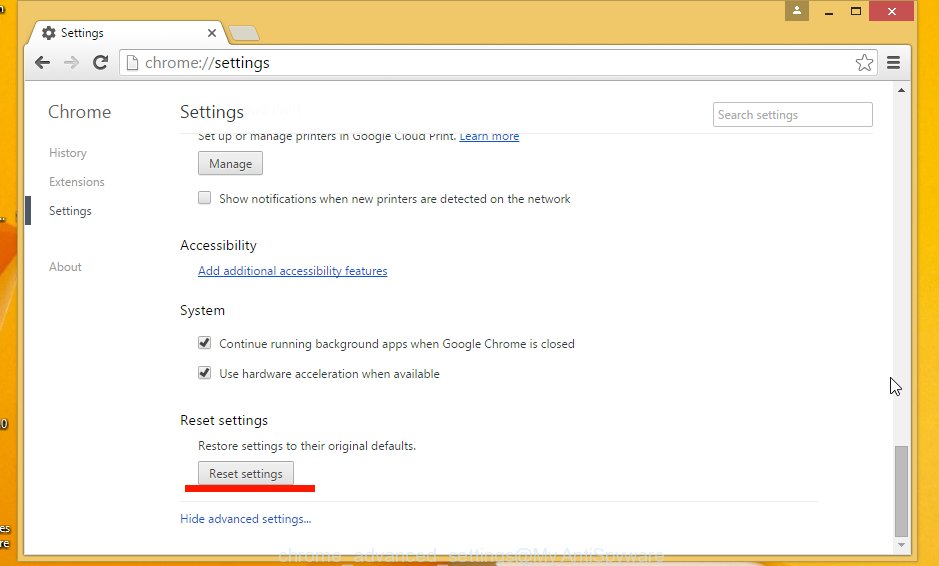
The Chrome will open the confirmation prompt. You need to confirm your action, click the “Reset” button. The program will start the process of cleaning. Once it is finished, the web-browser settings including the ‘block pop-ups’ option back to the values that have been when the Chrome was first installed on your PC.
Delete url.redirectcheck.pw from Firefox
If the Firefox settings have been changed by the adware, then resetting it to the default state can help you to remove the redirect onto url.redirectcheck.pw web site.
First, start the Firefox and click ![]() button. It will show the drop-down menu on the right-part of the web-browser. Next, click the Help button (
button. It will show the drop-down menu on the right-part of the web-browser. Next, click the Help button (![]() ) as shown below.
) as shown below.

In the Help menu, select the “Troubleshooting Information” option. Another way to open the “Troubleshooting Information” screen – type “about:support” in the web browser address bar and press Enter. It will open the “Troubleshooting Information” page as shown in the figure below. In the upper-right corner of this screen, click the “Refresh Firefox” button.

It will show the confirmation dialog box, click the “Refresh Firefox” button. The Mozilla Firefox will begin a task to fix your problems that caused by the adware. When it is finished, click the “Finish” button
Remove url.redirectcheck.pw redirect from Internet Explorer
To remove the url.redirectcheck.pw ads you need to reset the Internet Explorer to the state, which was when the Windows was installed on your computer.
First, start the Internet Explorer, then click ‘gear’ icon ![]() . It will display the drop-down menu on the right part of the browser, then click the “Internet Options” as shown in the figure below.
. It will display the drop-down menu on the right part of the browser, then click the “Internet Options” as shown in the figure below.

In the “Internet Options” screen, you need to select the “Advanced” tab and click the “Reset” button. The Microsoft Internet Explorer will open the “Reset Microsoft Internet Explorer settings” dialog box as on the image below. Next, click the “Delete personal settings” check box to select it. After that, click the “Reset” button.

When the process is finished, click “Close” button. Close the Internet Explorer and reboot your PC for the changes to take effect. This step will help you to restore your web-browser’s settings to default state and disable ‘ad-supported’ extensions.
Disinfect the browser’s shortcuts to delete url.redirectcheck.pw redirect
When the adware is started, it can also alter the browser’s shortcuts, adding an argument similar “http://site.address” into the Target field. Due to this, every time you start the web browser, it will be redirected to an unwanted ads.
To clear the internet browser shortcut, right-click to it and select Properties. On the Shortcut tab, locate the Target field. Click inside, you will see a vertical line – arrow pointer, move it (using -> arrow key on your keyboard) to the right as possible. You will see a text that starts with “http://” that has been added here. You need to remove it.

When the argument is removed, click the OK button. You need to clean all shortcuts of all your browsers, as they may be infected too.
Remove unwanted Scheduled Tasks
If the annoying url.redirectcheck.pw web-page opens automatically on Windows startup or at equal time intervals, then you need to check the Task Scheduler Library and remove all the tasks that have been created by ‘ad-supported’ applications.
Press Windows and R keys on the keyboard simultaneously. This displays a dialog box that called Run. In the text field, type “taskschd.msc” (without the quotes) and press OK. Task Scheduler window opens. In the left-hand side, press “Task Scheduler Library”, as shown below.
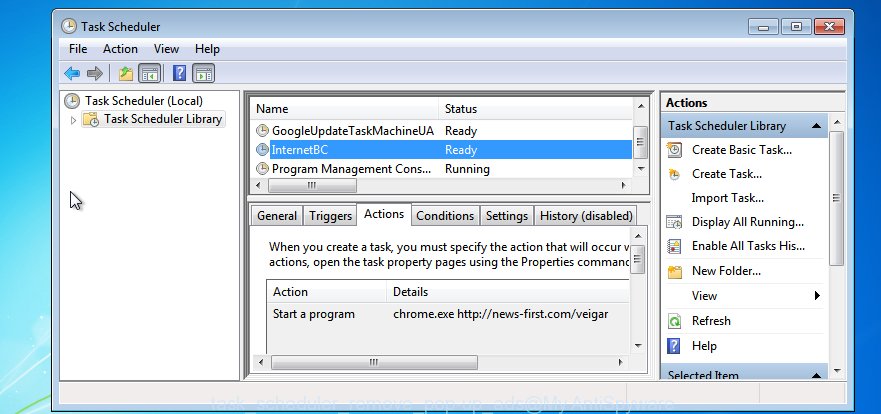
Task scheduler
In the middle part you will see a list of installed tasks. Select the first task, its properties will be show just below automatically. Next, press the Actions tab. Pay attention to that it launches on your personal computer. Found something like “explorer.exe http://site.address” or “chrome.exe http://site.address”, then you need remove it. If you are not sure that executes the task, check it through a search engine. If it’s a component of the adware, then this task also should be removed.
Having defined the task that you want to delete, then click on it with the right mouse button and select Delete as shown in the following image.

Delete a task
Repeat this step, if you have found a few tasks that have been created by malicious software. Once is finished, close the Task Scheduler window.
How to delete url.redirectcheck.pw redirect automatically
Manual removal is not always as effective as you might think. Often, even the most experienced users can not completely get rid of url.redirectcheck.pw pop-up ads from the infected system. This is because the ‘ad-supported’ software can hide its components which are difficult for you to find out and remove completely. This may lead to the fact that after some time, the ad supported software again infect your personal computer and it will begin to show annoying url.redirectcheck.pw pop-up ads. Moreover, I want to note that it is not always safe to delete adware manually, if you do not have much experience in setting up and configuring the system.
I suggest using the Malwarebytes Free which are completely clean your personal computer. It is an advanced malware removal application developed by (c) Malwarebytes lab. This program uses the world’s most popular anti-malware technology. It is able to help you remove browser hijackers, malware, ‘ad-supported’ software, toolbars, ransomware and other security threats from your PC system for free.
Now, press the link below to download Malwarebytes Free on your system. Save it on your Windows desktop or in any other place.
327070 downloads
Author: Malwarebytes
Category: Security tools
Update: April 15, 2020
Once the downloading process is finished, close all applications on your system. Next, open the setup file named mb3-setup. If the “User Account Control” dialog box pops up as shown on the image below, press the Yes button.

It will open the “Setup wizard” which will help you install Malwarebytes on your PC. Follow the prompts and don’t make any changes to default settings.

Once installation is finished successfully, click Finish button. Then Malwarebytes will automatically start and you can see its main screen as on the image below.
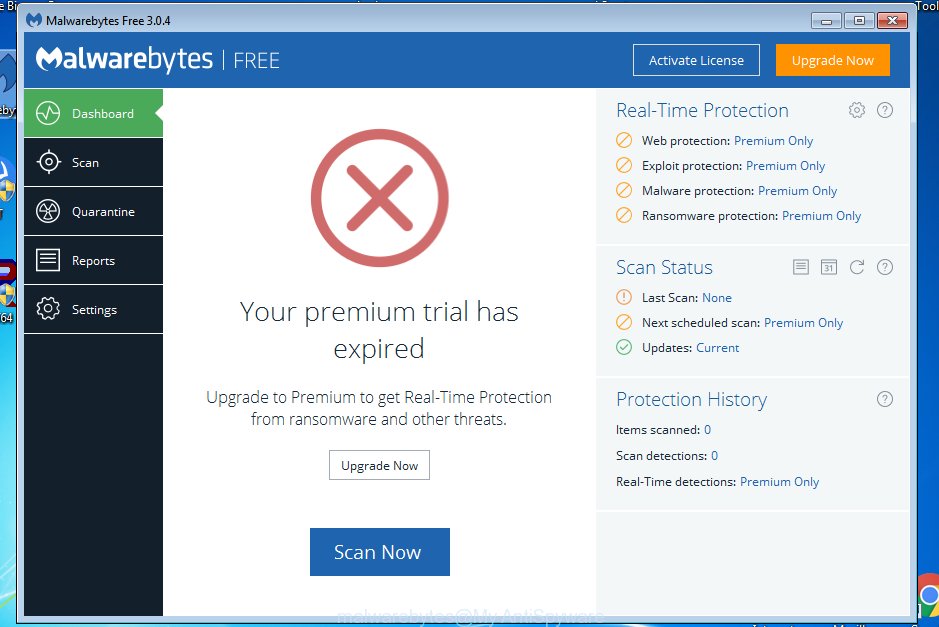
Now click the “Scan Now” button . This will start scanning the whole personal computer to find out ‘ad-supported’ software that cause a redirect to url.redirectcheck.pw. Once the ‘ad-supported’ software or malware is found, the number of the detected objects will change accordingly. Wait until the the scanning is done. Please be patient.
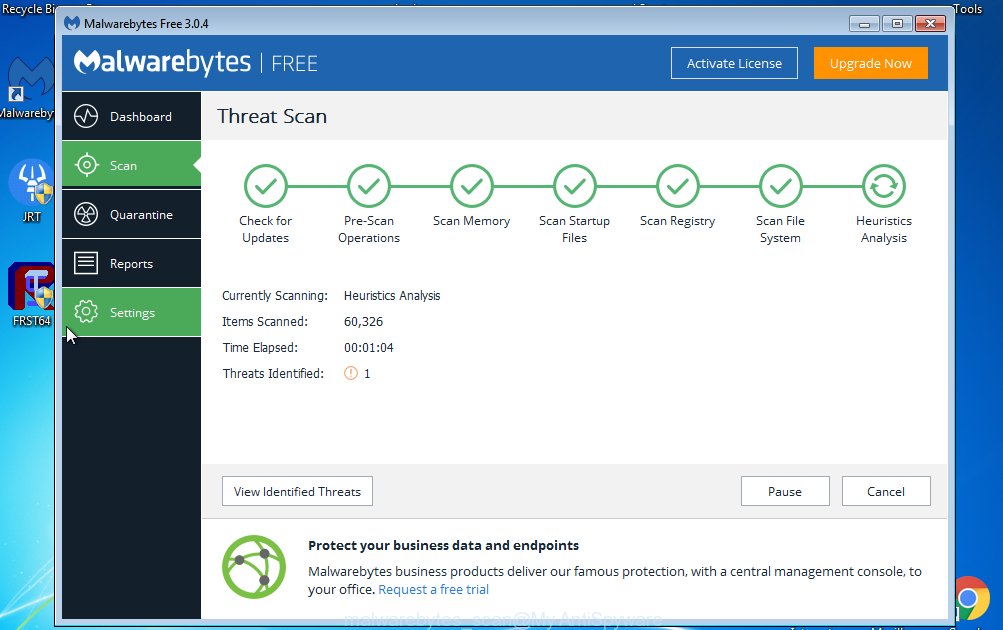
When it has finished scanning your personal computer, you can check all threats detected on your machine. Make sure all entries have “checkmark” and press “Quarantine Selected” button. The Malwarebytes will start removing malware and adware which cause url.redirectcheck.pw . Once disinfection is done, you may be prompted to reboot your computer.
I suggest you look at the following video, which completely explains the procedure of using the Malwarebytes application to get rid of adware and other malware.
How to block url.redirectcheck.pw
To increase your security and protect your PC system against new annoying advertisements and malicious web-sites, you need to use an application that blocks access to dangerous ads and sites. Moreover, the program can block the open of intrusive advertising, that also leads to faster loading of web pages and reduce the consumption of web traffic.
- Download AdGuard application from the following link.
Adguard download
26842 downloads
Version: 6.4
Author: © Adguard
Category: Security tools
Update: November 15, 2018
- When the download is done, start the downloaded file. You will see the “Setup Wizard” window. Follow the prompts.
- When the setup is finished, click “Skip” to close it and use the default settings, or press “Get Started” to see a quick tutorial that will help you get to know AdGuard better.
- In most cases, the default settings are enough and you do not need to change anything. Each time, when you start your PC system, AdGuard will start automatically and block pop-up ads, url.redirectcheck.pw redirects, as well as other malicious or misleading web pages. For an overview of all the features of the application, or to change its settings you can simply double-click on the AdGuard icon, which is located on your Windows desktop.
Scan your personal computer and remove url.redirectcheck.pw pop-ups with AdwCleaner.
This removal program is free and easy to use. It can scan and remove ad-supported software, browser hijackers, malware and unwanted toolbars in Chrome, Firefox, IE and MS Edge web browsers and thereby restore back their default settings (homepage and search engine by default). AdwCleaner is powerful enough to find and get rid of malicious registry entries and files that are hidden on the personal computer.
Download AdwCleaner tool from the link below. Save it to your Desktop so that you can access the file easily.
225545 downloads
Version: 8.4.1
Author: Xplode, MalwareBytes
Category: Security tools
Update: October 5, 2024
After the download is finished, open the directory in which you saved it and double-click the AdwCleaner icon. It will launch the AdwCleaner utility and you will see a screen as shown below. If the User Account Control prompt will ask you want to open the program, press Yes button to continue.

Now, press the “Scan” for scanning your computer for the adware which cause a redirect to url.redirectcheck.pw advertisements.

When it has finished scanning, it will display a list of all items detected by this utility as shown on the image below.
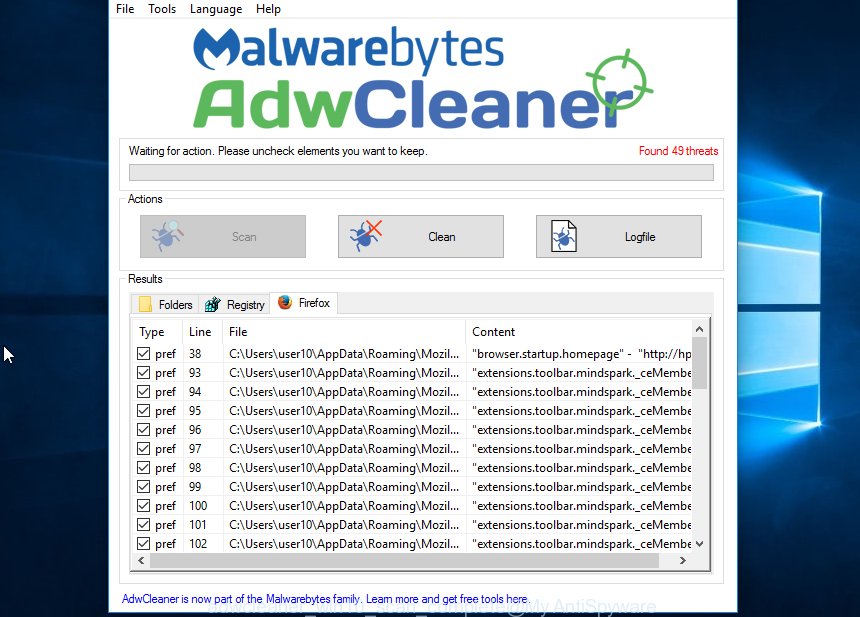
You need to press “Clean” button. It will open a dialog box, click “OK” to start the cleaning process. Once the clean-up is done, the AdwCleaner may ask you to reboot your computer. After reboot, the AdwCleaner will open the log file.
All the above steps are shown in detail in the following video guide.
Finish words
Now your machine should be free of the url.redirectcheck.pw advertisements. Remove AdwCleaner. We suggest that you keep AdGuard (to help you block unwanted pop-up ads and unwanted dangerous web pages) and Malwarebytes (to periodically scan your PC system for new malware and adware). Make sure that you have all the Critical Updates recommended for Windows OS. Without regular updates you WILL NOT be protected when new dangerous applications and ad supported software are released.
If you are still having problems while trying to remove url.redirectcheck.pw pop-ups from your PC system, then ask for help in our Spyware/Malware removal forum.

















